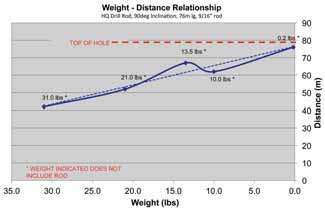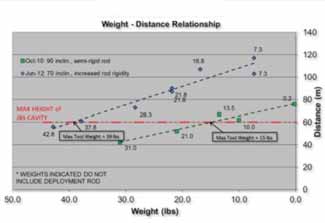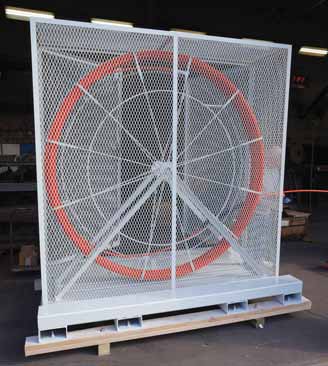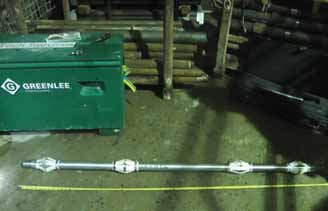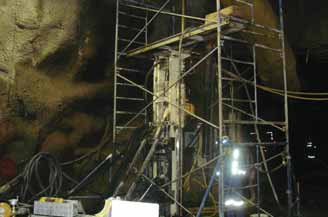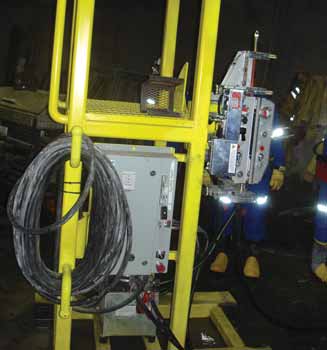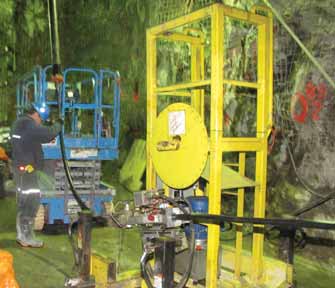Cameco Corp.’s Cigar Lake uranium project located in north-ern Saskatchewan, Canada, is considered the world’s largest
undeveloped high-grade uranium deposit. Cigar Lake is cur-rently in development with a target to begin commissioning
the mining process in ore by mid-2013, and ramp-up to full
production by the end of 2017.
The Cigar Lake Technical Services Group—the company’s
on-site engineering team—along with the Geology depart-ment, has used geotechnical drilling rigs to deploy light-weight borehole survey tools for orientation mapping and
geotechnical logging of underground boreholes. However, the
geotechnical rigs—large, powerful tools meant for high-thrust
applications—are labor intensive and expensive to operate,
and that money is better spent on the drilling operations they
were designed to do.
“The drills are in high demand for use in conventional
applications,” said Devon Loehr, Cameco mechanical engi-neer. “So, availability of the drills for survey tool deployment,
and crews to run them, is limited.”
The Technical Services Group (TSG), realizing that using
geotechnical drills for survey probe deployment was ineffi-cient, sought an alternative approach—one that was smaller,
compact and mobile—that could accommodate their need for
deployment of survey probes, weighing approximately 10 to
50 lb each, into overhead vertical 5-in.-diameter boreholes.
While searching the Internet, TSG discovered the Powered
Duct Rod Pusher by General Machine Products Co. (GMP) of
Trevose, Pennsylvania, USA. The device is designed for push-ing continuous lengths of specialized fiberglass rod through
utility conduits. Prior to the development of the Portable
Powered Duct Rod Pusher, utility construction work crews
usually had to manually push
3
⁄8- or ½-in.-diameter fiberglass
rods into conduits 1,000- to 1,200-ft long—a method that
was difficult and time-consuming.
The introduction of GMP’s Portable Powered Duct Rod
Pusher changed all of that; the mechanized pusher was able
to muscle rods through crowded or collapsed conduits with-out need of human effort. The machine features two oppos-ing drive tracks that securely clamp down on a fiberglass rod.
Its hydraulic drive motors then push the rod into the conduit
with a force of about 300 lb at speeds up to 130 ft/minute,
substantially more force than two men can generate on a con-tinuous basis. Once the rod is pushed to the end of the con-duit, a pulling line is attached to the end and pulled back by
the machine. The conduit is now prepared for pulling a cable
using the pulling line.
“The Portable Powered Duct Rod Pusher proves to be a
very efficient way to rod and place pull lines in utility conduit
systems,” said Bob Young, sales and applications engineer for
GMP. “It can be up to four to six times more productive than
traditional hand work methods.”
The original design enabled the device to push fiberglass
rod along relatively horizontal planes, handling just the
weight of the rod itself plus friction. But, was the pusher
powerful enough to push rods 200 ft vertically, Loehr won-dered. While it could generate 300 lb of force with its
hydraulic motor system, the TSG team needed to push up to
50 lb of survey instruments plus the weight of the rod. They
also wondered if the standard ½-in.-diameter fiberglass rod
would be stiff enough to vertically deploy the load into a 5-in.-inside diameter, steel-cased borehole.
GMP built a prototype specifically to meet the needs of
Cigar Lake’s unique application. This first prototype needed
only one modification: For use in the mine, GMP replaced the
gasoline engine driving the hydraulic power pack with a 600-volt electric motor. Loehr also had GMP supply a ½-in. Duct
Rodder (in its normal cassette) and the Portable Powered
Duct Rod Pusher without its carriage. Cameco would fabri-cate a frame for mounting the power pack and pusher (also
referred to as the drive head).
Once the GMP equipment arrived at the mine, additional
modifications were made in preparation for underground ver-tical borehole testing, including a skid to which the power
pack and drive head were attached, and a cage that con-tained the Rodder and cassette.
After the preliminary work was completed, the Portable
Powered Duct Rod Pusher was put to the test. The first trial
sent a bare rod (without tool weight) up a 258-ft-long, 3-in.-diameter, near-vertical borehole. The machine easily pushed a
distance of 252 ft under those conditions. After that, different
simulated tool weights were added and the results were meas-ured for each test. Testing conducted with a standard ½-in. rod
proved sufficient to deploy simulated tools of various weights
to distances of 137 to 252 ft. This satisfied the deployment
requirements of several existing survey instruments.
But the tests also exposed issues concerning the stiffness
of the fiberglass rods; they were bending, snake-like, from tool
weight and self-weight, thus creating friction against the inner
wall of the borehole. Because long-term applications would
require deployments into even larger (up to 5-in.) boreholes,
“we needed to solve the serpentine problem,” Young said.
To achieve the desired distances and borehole diameters
without rod deflection, GMP provided a thicker, stiffer 5/8-in.-diameter fiberglass rod. However, the thicker rod required a
much larger storage cassette. GMP fabricated this to accommodate a larger minimum radius for curvature. Although the
storage cassette was relatively large and cumbersome, its pri-mary purpose was containment of the rod during transport
from surface to underground. Once the storage cassette and
rod were underground, the required rod length would be cut
from the reel and stored on pipe racks on the tunnel walls.
With the final modifications complete, the new rod type was
tested. To better simulate the actual conditions of the long-term application, the retesting was carried out in a longer and
larger borehole (the largest diameter available at the time of
testing) at Cameco’s nearby McArthur River operation.
The results from retesting significantly longer deploy-ments, within larger diameter boreholes, and with greater
tool weight loads, were positive. The new, stiffer rod provid-ed deployment of vertical distances of 180 to 377 ft, with
simulated tool weight loads of 42.8 to 7.3 lb, respectively.
Results from testing with the original diameter rod are also
shown in the figure below for comparison.
The capacities and distances achieved with the cus-tomized ‘Vertical Rod Pusher’ are expected to easily satisfy
primary long-term application requirements involving a 200-ft deployment of approximately 25 lb within a 5-in. borehole
diameter. In fact, the new, stiffer rod allows deployment
weights of up to 39 lb, within a 4-in. borehole diameter, at a
distance of approximately 200 ft.
The success of GMP’s new Vertical Rod Pusher eliminated
the need to use very costly geotechnical drill rigs for deploy-ing survey instruments at Cigar Lake, where it will contribute
to savings by reducing labor and equipment inefficiencies.
Time will be the ultimate judge, but for now, the new Vertical
Rod Pusher offers a potential solution for other mining com-panies that have similar application requirements.
“GMP came through for us,” said Loehr. “They were respon-sive to every suggestion and engineering request. Together, we
have developed a cost-effective solution for a troubling and
expensive mining application. I’m glad we partnered with GMP."
Information for this article was provided by Cameco and
General Machine Products Co. Devon Loehr is a mechanical
engineer with the Technical Services Group of Cameco’s
Cigar Lake project. Bob Young is a sales and applications
engineer for General Machine Products Co. He can be
reached at 215-630-6264 or ryoung@gmptools.com.

